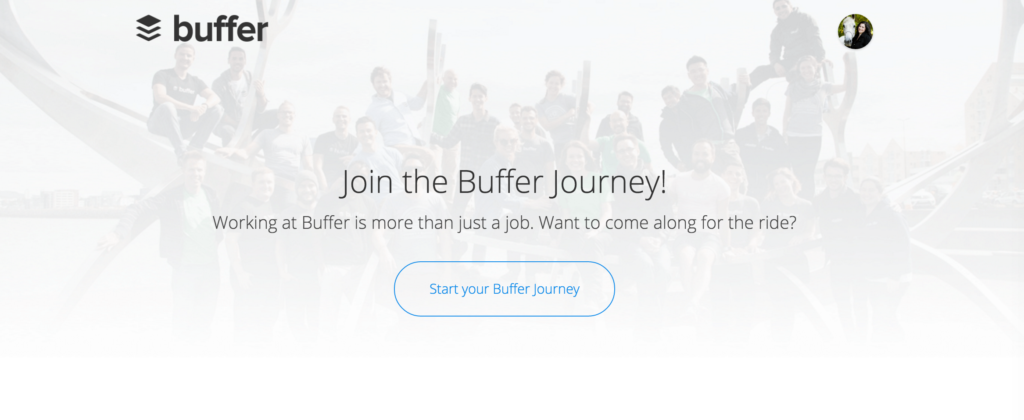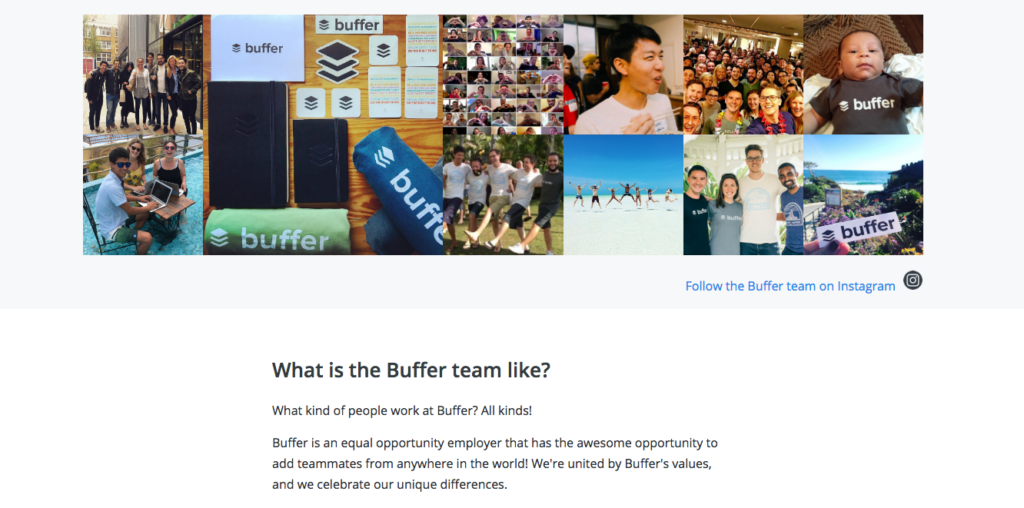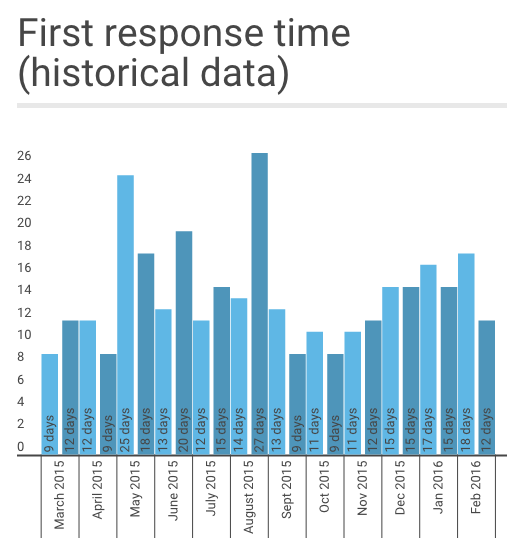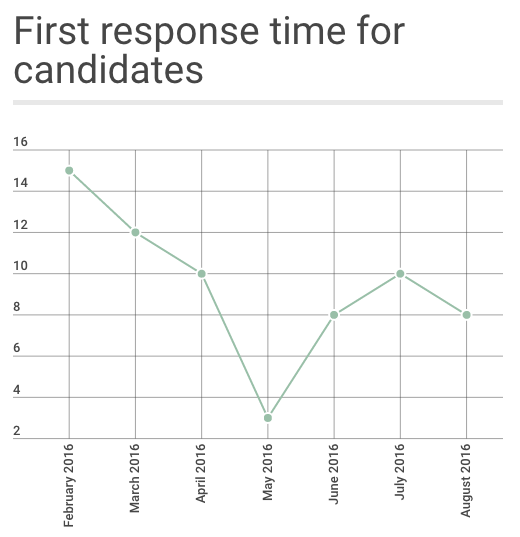We’ve shared a bit in the past about what we believe creates a great fit at Buffer, but the hiring process is so much more than these factors alone. How do you create a positive experience for all candidates, regardless of the outcome? How do you avoid bias and view all candidates through a lens of equality?
We don’t know all the answers to these questions, but we’re always experimenting and learning. As a result, we’ve developed five core philosophies that guide our efforts. I’d love to share them with you here!
What hiring at Buffer looks like in 2016
First, a bit of background. In less than 2 years, our team has grown from 17 to 79 people. In the past year, we’ve revised our hiring process to suit our needs as a scaleup company.
I joined as Buffer’s first Culture Scout in October 2015, when we went from growing the team by 1–2 people per month to being on the lookout for 30–40 team members between September 2015 and April 2016.
Some of my first responsibilities included shaping a newer framework for hiring, selecting, and interviewing; along with creating a great candidate experience and getting to know people in a consistent and unbiased way.
In April 2016, we expanded the People team further when Jenny joined and helped us further define the hiring process.
With a team of about 80 right now, we’re deliberately growing slower and only hiring for a few more roles in the coming months. We are looking more carefully at the needs of each area, digging into the ‘why’ in each role, and applying a more disciplined financial lens that allows us to grow more in-line with our revenue rate.
Rather than trying to set up a strict set of rules that might not stretch with our growth over time, we’ve made the decision to rely on our Culture Scouting philosophies instead.
We believe these philosophies and best practices may stick around for longer that a ‘process’ (the same way we believe defining your culture’s values can help with many other decisions.)
Our 5 hiring philosophies
Here are five ‘philosophies’ we try to live by (and have sometimes failed at) and some of the lessons that might be of interest to others growing a team:
1. Define what we need before we start looking
We’ve found the best time to find a consensus on a role and what skills it mgiht require is before we hire, not while we’re reviewing candidates.
We brainstorm with our teams on what their needs are and collectively write the listings. One of the ways we’ve found works well is to ask ourselves the questions like:
- What goals need to be achieved a year from now for us to consider this a successful hire?
- What would an amazing candidate accomplish in a year?
- For an amazing candidate to accomplish that, what do they need to do during the 45-day bootcamp?
- What are the traits, skills and qualifications this person will need to be successful?
One unique aspect of defining a role for us is having the team agree on whether a craftsperson (deeper knowledge/expertise in a specific area) or generalist (with T-shape skills) is needed. Making sure we have a training plan in place and getting everyone on the same page about the sequence of interviews enables consistent candidate evaluation and reduces total interview time.
We try to be honest about the skills needed while also keeping the door open for as many candidates as we can.
As a result, we work extensively on the job description, training plan, interview planning, interview question tailoring, etc. before we even post the listing.
2. Transparently share as much as we can

Our Journey page aims to reflect who we are as clearly as possible.
When we put all our cards on the table with full transparency, we’ve found it encourages candidates to be honest and do the same.
Some key elements of our jobs page include:
- Some info on how we work together remotely
- A list of all our culture perks
- Pictures of the team (in all sorts of settings!)
- Our commitment to diversity and equal opportunity employment
- Listings that set clear expectations for the role and measures of success

Our COO Leo gave a talk recently about how company culture isn’t something you can really shape, but rather how you have to sit, observe and write down what you see. The first step for us in looking to scale our hiring was to be clear on what our values were and articulate them honestly on our hiring page.
Once we had those values defined, it helped our interactions with candidates to make an objective decision about how closely they aligned with us.
3. Know what we’re evaluating with every interview question
It might seem a bit unusual, but we don’t ask for résumés during any part of our process. For our purposes, résumés don’t often give us the depth of information we’re looking for.
Instead, more weight goes into the messages that applicants share with us, both in writing and in chats. So it’s important that we have an unbiased way to know what we’re looking for.
We recently went through team training on managing bias that was enlightening from that standpoint, and our Inclusivity Catalyst, Courtney, is a great champion for keeping that top of mind.
We try to craft application and interview questions that will help us evaluate attributes we’ve predefined through our role needs and values. These sorts of questions can be a mix of verification questions, behavioral questions, situational questions, and skills tests.
We avoid any question that doesn’t provide useful information and might allow bias to creep in. (Here’s an incredibly helpful resource on the interview process that Google uses.)
Then we take it one step further: Before we ever speak to anyone, we already have an idea of a good answer, an OK answer, and a “pause answer” for any question we ask.
Say we’re asking a candidate to share a moment where they made a mistake. Depending on what they share, we might get insights on their transparency, empathy, vulnerability, and ability to “do the right thing” (which is one of our values!).
A potential good answer could include them admitting the mistake early on and owning up to it. Another good answer could be in their ability to reflect on the lesson they learned from the mistake.
Answers that might give us some pause could include hints of blaming others or circumstances, or sharing a mistake that puts them in the ‘savior’ position and misses the opportunity to show vulnerability.
Here are some other areas we craft questions to dig into. It’s important for our teammates to:
- Have a growth mindset (Do they like to learn and how?)
- Show a good bit of empathy (How do they react to technical glitches or misunderstandings.)
- Be okay with vulnerability (How open are they in the conversation?)
- Have a knack for working remotely (Do they have a track record of having shown drive in their professional or personal projects?)
- Have worked independently in the past. (Have they had to manage their own schedule to get something done?)
Then, we define questions that will give us a benchmark, knowing that there is no wrong or right. Everyone is different, but these benchmarks can indicate how well the candidate might do on our team.
As we scale our hiring and as the team grows, our interview questions have changed based on how our values have changed. We challenge these questions from time to time to ensure we know, “Why do we ask this?”
4. The ‘interview’ continues during bootcamp
While it might seem helpful to avoid overloading a candidate with information before they even start working, we believe that sharing expectations early on is one of the biggest favors we can do for both our new teammate and the whole team. (This is still something we’re striving for and haven’t quite nailed down!)
To set people up for success, we default to providing more context and sharing expectations early on.
For instance, if we bring on a full-stack developer who we later learn will spend 80% of their time working on backend development, we’ll tell that person as soon as we can in order to prevent any surprises.
Interviews and pre-hiring chats play a big role in new team members’ training and making sure they will truly feel at home at Buffer.
A candidate recently shared with me his feelings about our new-employee bootcamp at Buffer: “I love the idea of the 45-day bootcamp. Playing competitive sports my whole life growing up, no coach would bring players onto their team without seeing them in action first.”
Bootcamp not only gives everyone on the team the opportunity to get to know the bootcamper and explore some of the areas that interviews might not have shed the light on, but also allows the bootcamper to experience what working at Buffer really is like and compare it with their expectations before moving forward with their journey.
Our bootcamp generally lasts for 45 days, though sometimes it can be shorter or longer depending on the communication within teams and what challenges might arise. We are continually fine-tuning the bootcamp process to set everyone up for the most success possible.
So far in 2016, we’ve invited 36 people—24 people in Q1, 10 people in Q2 and two people in Q3—to join us for our 45-day bootcamp. About 90% of our team members continue with us past those 45 days (up from 70% last year).
5. Continuously work to improve the candidate experience
The group of people who check out the jobs page and step forward are very special to us.
It’s a very vulnerable experience to reach out, and we’re committed to making the application process at Buffer a positive one, no matter the outcome. Here are some key metrics that we aim for, regardless of the number of hires we are working on:
- Get back to all applicants in 10 days or less. Historically, we’ve been a bit all over the map here, with everything from nine days to an average of 25–27 days. Overall, it has most commonly been around 15 days.

We’ve tried a few things to get replies out more quickly to candidates: blocking out more time, sharing the task between several teammates, keeping each other accountable for a result of under 10 days first response time. We’ve had encouraging results, and today we’re at about 7-8 days for first response.

- Never leave more than three days between each step in the process. We think of this as “in the dark” time and try to minimize it. Two key things that have worked well for us here:
- 1. Be upfront with the candidate about the expected time they’ll hear from you
- 2. Use as many reminders and due dates as possible to keep yourself accountable (We use Trello, which is super handy!)
- Continually test and adjust the process. We tend to operate lean and scale as processes and theories are validated. We’ve gone through many iterations of our process and had a few bumps along the way, with response times being a bit too long and many different people juggling the role of hiring across many different teams. As we’ve recognized and defined our philosophies, the processes have been better ironed out and overall we’re able to provide a better service to our amazing applicants and our internal teams.
Interested in hearing about future roles at Buffer? Sign up here!* indicates requiredEmail Address *
Over to you
What pieces of the hiring process here resonate with you? Do you have any suggestions for how we can improve our process? What have been some of the best hiring processes you’ve experienced? We’d love to hear in the comments!
Try Buffer for free
190,000+ creators, small businesses, and marketers use Buffer to grow their audiences every month.


